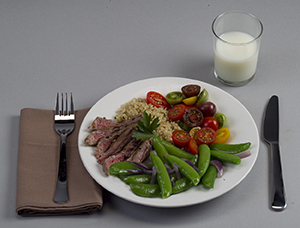Diabetes: Learning About Serving and Portion Sizes
Diabetes: Learning About Serving and Portion Sizes
Servings and portions. What’s the difference? These terms can be very confusing. But learning to measure serving sizes can help you figure out how many carbohydrates (“carbs”) and other foods you eat each day. They are also powerful tools for managing your weight.
Servings and portions
Many different words are used to describe amounts of food. If your health care provider uses a term you’re not sure of, don’t be afraid to ask. It helps to know the difference between servings and portions:
A serving size is a fixed size. Food producers use this term to describe their products. For example, the label on a cereal box could say that 1 cup of dry cereal = 1 serving.
A portion (also called a “helping”) is how much you eat or how much you put on your plate at a meal. For example, you might eat 2 cups of cereal at breakfast.
Using serving information
The portion you choose to eat (such as 2 cups of cereal) may be more than one serving as listed on the food label (such as 1 cup of cereal). That’s why it helps to measure or weigh the food you eat. Because the food label values are based on servings, you’ll need to know how many servings you eat at one sitting.
Ounces: 2 to 3 ounces is about the size of your palm. |
1 Cup: 1 cup (or a medium-sized piece) is about the size of your fist. |
1/2 Cup: 1/2 cup is about the size of your cupped hand. |
One tablespoon is about the size of your thumb.
One teaspoon is about the size of the tip of your thumb.
Keeping track of serving sizes
When you’re planning for a snack or a meal, keep servings in mind. If you don’t have measuring cups or a scale handy, there are ways to “eyeball” serving sizes, such as comparing your food to the size of your hand (see pictures above).
Managing portion sizes
If your weight is a concern, reducing your portions can help. You can eat more than one serving of a food at once. But to keep from eating too much at one meal, learn how to manage your portions. A portion is the amount of each type of food on your plate. See the plate diagram for an example of balanced portions.
Updated:
March 31, 2018
Reviewed By:
Image reviewed by StayWell art team.,Poulson, Brittany, RD, CDE



